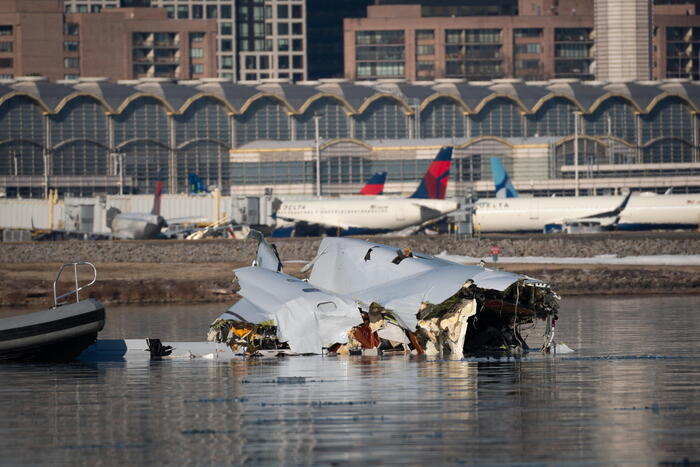Divers are working tirelessly in the frigid waters of the Potomac River in Washington, D.C., as recovery efforts continue more than 24 hours after a devastating mid-air collision between an American Airlines passenger jet and a U.S. Army Black Hawk helicopter. The crash, which claimed 67 lives, marks the deadliest air disaster in U.S. skies in 23 years.
Authorities have recovered more than 40 bodies from the river, a law enforcement official told the Associated Press on Friday morning. Meanwhile, search teams have retrieved two black boxes from the Bombardier CRJ700 operated by PSA Airlines. The aircraft had departed Wichita, Kansas, on Wednesday evening and was preparing to land on Runway 33 at Reagan National Airport when it collided with the military helicopter, which was conducting a training flight.
Washington, D.C., Mayor Muriel Bowser confirmed that all 64 people on board the commercial jet perished, along with the three soldiers aboard the Black Hawk.
President Donald Trump, speaking from the White House alongside Transportation Secretary Sean Duffy, described the tragedy as an “hour of anguish for the nation.” However, within seconds, his remarks took a political turn, as he accused his two Democratic predecessors, Joe Biden and Barack Obama, of prioritizing diversity-based hiring policies over competence. He claimed such initiatives compromised the requirements for mental sharpness and psychological strength needed to prevent such disasters.
Trump also suggested that the accident could have been averted, arguing that the helicopter could have been stopped, “but for some reason, no adjustments were made.”
The National Transportation Safety Board (NTSB) has launched an investigation to determine the cause of the collision and any potential lapses. Investigators are analyzing radar data, flight recordings, and radio transmissions to piece together the final moments before impact. A preliminary report is expected by the end of February.
Early findings from the Federal Aviation Administration (FAA) indicate that air traffic staffing levels at Reagan National were “not normal for the time of day and traffic volume” when the crash occurred. Two key concerns have emerged: first, that the distinct roles of coordinating helicopter traffic and managing arriving and departing planes had been improperly combined at the time of the accident; and second, that only a single air traffic controller was reportedly overseeing takeoffs, landings, and radio communications that evening. According to several reports, a second controller had left early with a supervisor’s approval.
Another focus of the probe is whether the Black Hawk was flying higher than its designated altitude—a point Trump seized on in a post on Truth Social: “It was WAY above the 200-foot limit. Not too hard to figure out, right?”
Signs of potential systemic issues extend beyond the crash itself. Just 24 hours earlier, another jet had aborted its landing at Reagan National to avoid a helicopter in its path. A similar incident occurred a week prior when a commercial flight from Charlotte had to delay landing due to a military helicopter operating nearby.
Reagan National is one of the country’s busiest airspaces, where commercial jets frequently share the skies with military and civilian helicopters due to the proximity of Anacostia-Bolling military base, located just across the Potomac.
According to air traffic control recordings, a tower operator had instructed the helicopter to pass behind the jet. The last recorded transmission came from the Black Hawk’s pilot: “PAT 2-5 has the aircraft in sight, requesting visual separation.” Thirteen seconds later, a startled exclamation from the control tower marked the moment of impact.
Among the passengers on board the doomed flight were more than a dozen figure skaters, coaches, and family members returning from the U.S. Figure Skating National Championships in Wichita. Russian pair skaters Evgenia Shishkova and Vadim Naumov, world champions in 1994, were among the victims, alongside former Soviet athlete Inna Volyanskaya. The still-incomplete casualty list includes several Chinese nationals and two U.S. attorneys, Sarah Lee Best and Elizabeth Anne Keys.
The Pentagon confirmed that the Black Hawk was carrying a pilot and two military personnel. So far, two victims have been identified: pilot Andrew Eaves and crew chief Ryan O’Hara, 29. The identity of the third soldier has not yet been released.












